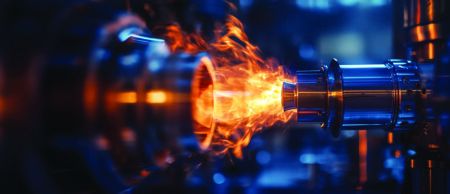Honeywell’s Boeing 757 testbed was among the first of its type delivered, going to launch customer Eastern Air Lines in February 1983. Later the aircraft served with the UK’s Airtours, before it joined Honeywell’s fleet in 2004. Four years later, the jet began its trials career and continues to average about 50 test flights per annum. Most obviously equipped for engine test work, with a large pylon mounted on its starboard forward fuselage, the 757 also flies vital avionics trials, including the testing of flight safety and passenger connectivity-related systems.
Joe Duval, a veteran of many years’ flying with the US Air Force, is Honeywell’s chief test pilot. He explains the basics of trials procedure with the 757: “The test installations are mostly engineered and implemented in-house by our flight test engineering team and technicians/mechanics. Being able to modify the airplane in-house, responding rapidly to our internal engineering customers, is key to providing a competitive edge for our products. We have six engineers, two engineering technicians, and four mechanics to manage test installations, data acquisition and regular aircraft maintenance.
“Larger projects, like a major modification to support engine testing, are overseen by flight test engineering, but would be designed by an outside firm. Computer-based modeling is used extensively for test installation design, and simulation is used before a higher risk test is performed, by way of a local airline’s 757 simulator.”
The aircraft is instrumented to record data from “thousands of capture points”, storing gathered information on servers offering “terabytes of capacity”. Duval notes that onboard storage is currently preferred over telemetry: “Engine testing can include several hundred parameters of data – mostly temperature and pressures – sampled throughout the engine and yielding large amounts of data. Furthermore, avionics testing (often done concurrently with engine testing) also generates large amounts of data.
“All this data is stored on onboard computers and typically offloaded directly after a flight. We’ve moved away from telemetry due to the localized (line-of-sight) requirement and throughput limitations. We do use some forms of internet-based data transfer, however, and with the new JetWave system’s bandwidth, we hope to increase real-time data transfer on some programs.”
Test configuration
Two pilots are required for every flight, typically accompanied by between five and seven engineers or technicians, one of them acting as primary flight test engineer (FTE) and test director. There are 20 seats in the cabin, however, facilitating the 757’s important additional role of technology demonstration to customers and media.
Avionics testing calls for accurate and unusual flying from Honeywell’s experienced pilots, who are selected “…extremely carefully to give us a good balance of experience and expertise across all of the testing scenarios that we create.”
If a weather radar system is under test, for example, the crew might go in search of storm systems, flying toward them to validate the radar and the warnings it provides on the flight deck. The crew also looks at the intuitiveness and ergonomics of displays, checking that radar data is delivered in a useful form.
In a recent test, Honeywell assessed the performance of its RDR-4000 IntuVue weather radar system against ice crystals, during work flown over Cayenne, French Guiana. Duval describes the effort, which was sponsored by the High Altitude Ice Crystals (HAIC) Consortium. “We had a very successful campaign, operating the IntuVue radar on the 757 as it followed one or two other aircraft in the same weather system. Those aircraft had multiple probes collecting information about the system, including ice content. The data they collected is combined to correlate what our radar sees.”
The HAIC trials are only one aspect of the 757’s IntuVue work. “The 757 has been used extensively throughout the world to prove the radar’s functionality, from low-level windshear testing to high-altitude radar functionality,” says Duval. “The cockpit displays are evaluated in the lab on computers before implementation in the airplane, but the human factors of those displays in the cockpit environment are evaluated on the airplane as well.”
European work
This year the 757 flew extensively over Europe, primarily testing the mechanically steerable, fuselage-mounted JetWave antenna. Honeywell exclusively produces the JetWave equipment to support Inmarsat’s Global Express (GX), a Ka-band broadband connectivity system for commercial aircraft. Already available to business aircraft operators as Jet Connex, the system will eventually draw on four satellites for global connectivity at speeds up to 50Mbps.
Duval explains the thinking behind the GX tests: “We want to be sure the system is robust, no matter how the airplane is maneuvered. Higher latitudes mean different angles to the satellite, and speed can also affect the angle of the airplane and therefore the angle of the antenna to the satellite. We maneuver through many altitudes and speeds, as well as extreme turns, to fully test the robustness of the system and its connection to the satellite.
“The first satellite in orbit is over the Indian Ocean and its furthest western coverage is over Western Europe. Also, our Honeywell office in Tewkesbury, Gloucestershire, is where a lot of the engineering for this system takes place. For those two reasons, we chose to operate out of Birmingham, but we’ll test the system over multiple regions to exercise the satellites and ground stations.”
Honeywell’s test fleet represents a considerable investment in resources and dollars, and multiple tests on different systems in the same flight are common, as demonstrated in the two recent visits to Europe. “The aircraft was involved in extensive datalink testing of the newest ground and airborne controller pilot datalink communication systems,” says Duval. “Specific routes were flown and multiple landings made to test systems throughout Europe. We also tested a new hybrid traffic collision and avoidance system. Both these tests are particularly interesting in Europe because of the vast amount of air traffic in the region.”
The ability to easily deploy the 757 away from its dedicated hangar at Phoenix’s Sky Harbor International Airport is important to Honeywell’s test and demonstration programs. Its size allows a degree of self-deployment capability and, despite its age, the airframe remains fully compliant. “The aircraft is kept worldwide capable from the standpoint of current air traffic mandates and the crew is trained for all areas of the world,” explains Duval. “For trips away from home, we travel with mechanics to look after the aircraft and a ‘fly-away kit’ containing consumables, tools, and repair items.”
Engine test
The 757’s engine test duties have most significantly involved it in proving the HTF7000 series of small turbofans aimed primarily at business aircraft, and the seminal TFE731, where test work continues in support of the latest developments of the 1972 vintage turbofan.
Duval explains the basics of the aircraft’s modifications and engine test procedures: “Because we have an internal FTE capability, the through-process for design of any test installation is to keep it as generic as possible. We can test all the propulsion products Honeywell produces, from turboprops to turbofans. The test installation has purposely been made universal, with adaptability to all these engine types. The pylon, fuel system, and so on, are designed to support engines up to 16,500 lb thrust.”
Flying engine test profiles places quite different demands on the flight deck crew, but still requires all the accuracy of an avionics test. “An engine test is planned for anywhere from four to seven hours, depending on its complexity,” says Duval. “Typically, our engine flights start out at a low altitude (5,000ft) and climb in a step pattern to various altitudes and airspeeds, ending at the highest altitude for that day’s test. Each test point has a specific altitude and airspeed that the pilots must precisely maintain. This can take quite a bit of coordination with air traffic control, unless we use a designated test area allowing a large block of airspace where we’re allowed to maneuver independently. Much of the time the engineers want to operate the engine as high as possible and as slowly as possible, and this is where the pilots really need a lot of skill, and where the 757 shines, since it has quite a large operating envelope.”
Under its flight test operations department, Honeywell’s wider flight test fleet includes examples of the Convair 580 and Beechcraft King Air turboprops; Rockwell Sabreliner, Dassault Falcon 900 and Cessna Citation V business jets; Embraer 170 airliner; and Airbus Helicopters AS350. Alongside the Boeing, these aircraft support Honeywell’s aerospace product line as their “first customer”, according to Duval. Flown by a small cadre of ex-commercial and military pilots, the flight test operations fleet and personnel deliver “…the flexibility to design and deliver safe and controlled airborne testing programs across the entirety of Honeywell’s portfolio.”
Paul E Eden is a UK-based freelance writer and editor specializing in the aviation industry.




